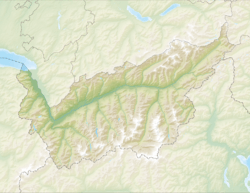Bratsch facts for kids
Quick facts for kids
Bratsch
|
||
|---|---|---|

Bratsch village
|
||
|
||
| Country | Switzerland | |
| Canton | Valais | |
| District | Leuk | |
| Municipality | Gampel-Bratsch | |
| Area | ||
| • Total | 6.2 km2 (2.4 sq mi) | |
| Elevation | 1,090 m (3,580 ft) | |
| Population | ||
| • Total | 490 | |
| • Density | 79.0/km2 (205/sq mi) | |
| Postal code |
3957
|
|
| Twin towns | Horw (Switzerland) | |
Bratsch is a lovely village located in Switzerland. It's nestled in the Valais region. This village is now part of a larger area called Gampel-Bratsch. It belongs to the Leuk district.
Bratsch used to be its own independent town. But on January 1, 2009, it joined with the nearby town of Gampel. Together, they formed the new municipality of Gampel-Bratsch.
Contents
History of Bratsch
Bratsch has a long history. It was first mentioned in old records way back in 1228. Back then, it was called Praes. Over the years, its name changed a few times. Some old names include Prahcs in 1309 and Prages in 1408. Finally, by 1532, it became known as Bratsch.
Bratsch's Coat of Arms
Every town has a special symbol called a coat of arms. Bratsch's coat of arms shows a church. The church is silver and has a cross on top. It sits on a green mountain. There's also a golden star and a wavy silver line. This wavy line likely represents a river.
People of Bratsch
In December 2002, Bratsch had about 490 people living there. Most people in Bratsch speak German. About 99% of the villagers speak German as their main language. A few people also speak Russian or French.
Many people in Bratsch were born right there. In 2000, about 63% of the people were born in Bratsch. Another 33% were born elsewhere in the same region. Only a small number of people were born outside Switzerland.
Most homes in Bratsch are single-family houses. In 2000, about 70% of the buildings were single homes. There were also some buildings with multiple apartments. Many apartments are used all year round. Others are used only during certain seasons, like for holidays.
Here's how the population of Bratsch has changed over time:

Bratsch's Economy
In 2010, Bratsch had a very low unemployment rate. This means almost everyone who wanted a job had one. In 2008, many jobs were in farming. There were also some jobs in manufacturing. Other jobs were in services, like hotels and restaurants.
Most people who live in Bratsch work outside the village. In 2000, 211 people traveled out of Bratsch for work. Only 6 people came into the village to work. This means Bratsch is a place where many people live but work elsewhere.
Religion in Bratsch
Most people in Bratsch are Roman Catholic. In 2000, about 97% of the population were Catholic. A small number of people belonged to the Swiss Reformed Church. Very few people said they had no religion.
Education in Bratsch
Many people in Bratsch have a good education. About 36% of the population finished high school. Some people, about 5%, went on to get a higher education. This means they attended a university or a special college. Most of these highly educated people were Swiss men.
In 2000, 64 students from Bratsch went to schools outside the village.




